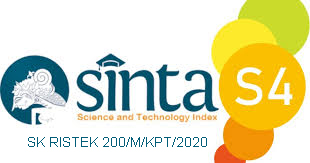PREDICTION OF INCOMING ORDERS USING THE LONG SHORT-TERM MEMORY METHOD AT PT. XYZ
Abstract
Keywords
Full Text:
PDFReferences
Hochreiter, S., & Schmidhuber, J. (1997). LSTM 1997. Neural Computation.
Ou, Y., Qian, H., & Xu, Y. (2009). Support vector machine based approach for abstracting human control strategy in controlling dynamically stable robots. Journal of Intelligent and Robotic Systems: Theory and Applications. https://doi.org/10.1007/s10846-008-9292-8
Qian, M., Hongquan, W., Yongsheng, W., & Yan, Z. (2008). SVM based prediction of Spontaneous Combustion in Coal Seam. Proceedings of the 2008 International Symposium on Computational Intelligence and Design, ISCID 2008. https://doi.org/10.1109/iscid.2008.193
Tseng, Y. C., Chen, C. C., Lee, C., & Huang, Y. K. (2007). Incremental in-network RNN search in wireless sensor networks. Proceedings of the International Conference on Parallel Processing Workshops. https://doi.org/10.1109/ICPPW.2007.47
Biegel, J. E. (1961). Statistics in Forecasting. Management International, 162-181.
Buffa, Elwood S., dan Sarin, R. K. (1996). Manajemen Operasi dan Produksi Modern. Edisi 8. Jakarta: Binarupa Aksara.
Wheelwright, S., Makridakis, S., Makridakis, S., Wheelwright, S., Gross, C. W., Peterson, R. T., … O’Neill, W. J. (1978). Forecasting Methods for Management. Journal of Marketing Research. https://doi.org/10.2307/3150640
Mitropolsky, I. A. (1967). Averaging method in non-linear mechanics. International Journal of Non-Linear Mechanics, 2(1), 69-96.
Kitagawa, G. (1991). A nonlinear smoothing method for time series analysis. Statistica Sinica, 371-388.
Andrews, D. F. (1974). A robust method for multiple linear regression. Technometrics, 16(4), 523-531.
Willmott, C. J. (1981). On the validation of models. Physical geography, 2(2), 184-194.
Cheung, Y. W., & Lai, K. S. (1995). Lag order and critical values of the augmented Dickey–Fuller test. Journal of Business & Economic Statistics, 13(3), 277-280.
Rescher, N. (1998). Predicting the future: An introduction to the theory of forecasting. SUNY press.
Syntetos, A. A., Babai, Z., Boylan, J. E., Kolassa, S., & Nikolopoulos, K. (2016). Supply chain forecasting: Theory, practice, their gap and the future. European Journal of Operational Research, 252(1), 1-26.
Dickey, David A dan Wayne A. Fuller, (1979), Distribusi of Estimators for Autoregressive Time Series With a Unit Root, Journal of the American Statistical Association, Vol. 74, No. 366
DOI: https://doi.org/10.31326/jisa.v4i1.902
Refbacks
- There are currently no refbacks.
Copyright (c) 2021 Lukman Irawan, Fauzi Fauzi, Denny Andwiyan

This work is licensed under a Creative Commons Attribution-ShareAlike 4.0 International License.
JOURNAL IDENTITY
Journal Name: JISA (Jurnal Informatika dan Sains)
e-ISSN: 2614-8404, p-ISSN: 2776-3234
Publisher: Program Studi Teknik Informatika Universitas Trilogi
Publication Schedule: June and December
Language: English
APC: The Journal Charges Fees for Publishing
Indexing: EBSCO , DOAJ, Google Scholar, Arsip Relawan Jurnal Indonesia, Directory of Research Journals Indexing, Index Copernicus International, PKP Index, Science and Technology Index (SINTA, S4) , Garuda Index
OAI address: http://trilogi.ac.id/journal/ks/index.php/JISA/oai
Contact: jisa@trilogi.ac.id
Sponsored by: DOI – Digital Object Identifier Crossref, Universitas Trilogi
In Collaboration With: Indonesian Artificial Intelligent Ecosystem(IAIE), Relawan Jurnal Indonesia, Jurnal Teknologi dan Sistem Komputer (JTSiskom)
JISA (Jurnal Informatika dan Sains) is Published by Program Studi Teknik Informatika, Universitas Trilogi under Creative Commons Attribution-ShareAlike 4.0 International License.


















